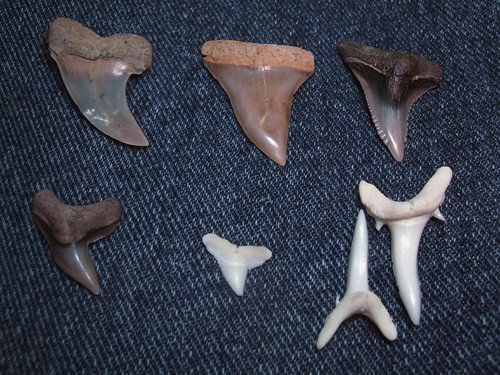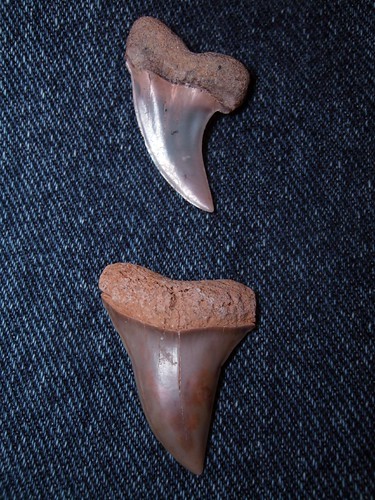Top row from left:Isurus planus, Isurus (Carcharodon) hastalis, Hemipristis serra
Bottom row from left: Physogaleus contortus, Carcharinus perezii, Carcharias taurus.
If you're wondering what the above names represent well...lets do a run down.
Isurus hastalis aka Carcharodon hastalis (4-6 million years ago) is the direct ancestor of the modern great white which pretty much tells you all you need to know about why these look a bit like steak knives. Isurus is the genus of modern makos whereas Carcharodon is the genus of the modern great white.
(top I. planus, bottom I. hastalis)
Isurus planus is a pacific hooktooth mako from around 15 million years ago. I'm guessing the hook is designed for grabbing faster moving fish prey and holding it.
Hemipristis serra (14-17 million years ago) is a bit of an oddity - it has the largest serrations of any shark in history (so far discovered). Its much smaller living relative uses serrated teeth to open up molluscs and crustaceans.
Physogaleus contortus is a species I know very little about - it evolved alongside and close to the genus Galeocerdo which contains our modern tiger shark; one of the world's true superpredators and a bit of a generalist in terms of prey.
Carcharinus perezii is the modern caribbean reef shark, a fairly typical reef shark and a fish predator. This tooth (a very small one) was the only one I could find in the aftermath of this dive.
Carcharias taurus is the modern Sand Tiger (aka Grey Nurse or Raggedtooth) shark although teeth at least 5 million years old. I collected these teeth myself from the floor of one of the Raggie Caves of Protea Banks, South Africa. This is a slow moving fish predator that ambushes prey with sudden bursts of speed.
To buy fossil shark teeth (please don't buy modern teeth - the shark has probably been fished inappropriately) I recommend Steve's fossil shark teeth.
Here's none of the above - a Zebra shark, Stegasoma fasciatum, and young fan (taken underwater with me inside a public aquarium looking out (yes it is as weird a feeling as you'd think)).



No comments:
Post a Comment